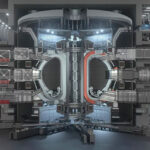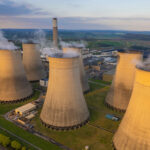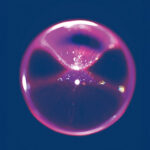Nuclear fusion, moving closer to replicating the sun's energy
Fusing the nuclei within atoms could offer humanity a clean and virtually boundless energysource, although various technical and economic challenges must first be overcome.

How exactly do stars manage to stay bright for so long? Humankind has been dreaming of finding an inexhaustible source of energy since the times of ancient Greece, when people were already looking up to the sky in wonder. It is an Utopian idea, as the first law of thermodynamics holds that producing infinite energy is impossible. Undaunted, scientific research has been unsuccessfully pursuing this dream for thousands of years. Today, we are close to achieving not only (almost) infinite, but also clean energy, thanks to nuclear fusion, a technology that mimics the process that keeps stars alive.
“Nuclear fusion is a process in which two light nuclei are brought together to form a heavier nucleus, releasing an immense amount of energy in the process. We know that this reaction occurs naturally in stars such as the Sun, but achieving the right conditions for this to happen on Earth is no easy task,” explains Dr. Erik Fernández, managing director of the Spanish Science Industry Association (INEUSTAR), which was set up to champion innovation and the advancement of science around the world.
Nuclear fusion should not be confused with nuclear fission, which is the well-known process used by nuclear power plants worldwide to gener ate electricity. Fission involves splitting atoms of elements such as uranium and plutonium—both heavy elements— to release energy. While this process is efficient and produces no direct greenhouse gas emissions, it has the disadvantage of generating waste that remains radioactive for thousands of years.
In contrast, nuclear fusion fuses light atoms, such as deuterium and tritium (hydrogen isotopes). Another big advantage offered by fusion is that, in addition to not emitting greenhouse gases, the waste loses its radioactivity over a shorter period of time. For these reasons, this solution has been considered the Holy Grail of energy for many decades.
The challenge of taming the energy of a star
Imagine two magnets that want to come together. If they approach each other with the same pole, they repel each other. Something similar happens with the nuclei of atoms, so if we want to fuse them, extreme conditions are needed to overcome this repulsion. According to Dr. Fernández, the atoms must be heated to extremely high temperatures, above 100 million degrees Celsius, so that the particles can pass into a state of matter known as “plasma.” On top of that, we need to apply immense pressure to bring the nuclei close enough to fuse.
Dr. Erik Fernández (INEUSTAR): “If we succeed, it will be a truly momentous achievement in the field of energy by providing a clean, safe, and almost limitless energy source”
Here, the magnetic fields generated by superconducting magnets play a crucial role: they enable the plasma to remain in the right condition just long enough for the nuclei of the atoms to fuse. This is essential because, without this magnetic confinement, the particles would become scattered.
“This extremely complex process is what scientists and technologists are attempting to replicate in an efficient and controlled manner. If we succeed, it will be a truly momentous achievement in the field of energy by providing a clean, safe and almost limitless source of energy,” proclaims Dr. Fernández. That said, “complex” does not necessarily mean “impossible,” as nuclear fusion has been successfully achieved on several occasions. The main problem, however, is that in most cases, more energy has been put in to create the reaction than the amount ultimately released.
A historic breakthrough was achieved in December 2022, when the National Ignition Facility (NIF) in the United States achieved, for the first time, a net energy gain through nuclear fusion; that is, it generated more energy from the fusion process than the amount used to create it. This experiment has been replicated several times since, thus demonstrating that nuclear fusion is not just a pipe dream. However, the challenge now lies in implementing this experimental achievement on a large scale.
Robert Arnoux (ITER): “Nuclear fusion is probably the most complex challenge humanity has ever faced from a technological and industrial standpoint and also in terms of the physics involved”

Toward industrial-scale fusion energy
José Miguel Carmona, a doctor in physics from the Complutense University of Madrid and head of the fusion area at AVS (Added Value Solutions), notes that “immense progress has been made over the last few decades in nuclear fusion, partly thanks to the construction and operation of various experimental machines, which have given us the knowledge we need to find more efficient ways of producing energy.” AVS is a Spanish company and a world leader in the design and development of complex space equipment for large scientific and space facilities. This complexity lies in the fact that the equipment for large scientific and space facilities must continue to work while out in space, without breaking up amid such hostile conditions. These conditions happen to be similar to those found inside a nuclear fusion reactor: extreme temperatures, high magnetic fields, and copious amounts of radiation. It is precisely its knowhow in creating the sophisticated and innovative technology needed to reach out into space that has prompted it to try its hand at nuclear fusion, a sector in which there are currently very few initiatives in progress, and which also happens to require a sizable capital outlay.
Dr. José Miguel Carmona (AVS): "Immense progress has been made in nuclear fusion over the last few decades, thanks in part to the construction and operation of various experimental machines"
“Nuclear fusion is probably the most complex challenge humanity has ever faced from a technological and industrial standpoint and in terms of the physics involved. For fusion to become a viable energy source, we must achieve a net energy gain considerably higher than the amount put in to make fusion happen,” explains Robert Arnoux of ITER (International Thermonuclear Experimental Reactor), the world’s largest international fusion experiment. Since 1985, it has brought together 35 countries —including China, South Korea, the United States, India, Japan, Russia and various EU Member States— with the total investment exceeding €22 billion (according to a European Parliament document, the final bill could be many billions more). Unlike the NIF, ITER was conceived “as the key experimental step between the fusion research machines of today and the fusion power plants of tomorrow.” It is now vying to produce 500 MW of fusion energy in exchange for 50 MW to make it happen.

Dr. Fernández reckons that “we can be optimistic that fusion will ultimately become a reality. It is only a matter of time before we overcome the technological challenges of building a facility capable of extracting energy from the fusion process in an efficient way.” He believes it may be several decades before we can have fusion power in our homes, although the recent inflow of private capital may shorten this waiting time.
Further technological developments may also bring things forward, mainly in the fields of supercomputers and artificial intelligence. According to Arnoux, these key technologies may become very important for ITER, as they allow us to predict and avoid problems that could end up disrupting the fusion process: “Using models developed by AI we can predict faster-than-real-time fusion plasma evolution and be able to foresee potential problems, such as instabilities due to excessive pressures/current densities in the plasma, and adjust the parameters in real time to keep conditions stable”, he explains.
Dr. Carmona believes that a paradigm shift is now upon us, thanks to the progress made in building ITER: “We are living in truly fascinating times, where major projects are still being built, satellite programs are providing invaluable information, and startups are taking advantage of the current state of the art —in some cases, standing on the shoulders of giants— as they try to show that their technology has the potential to outperform the rest.” He adds: “Fusion is the air we need in this scenario; the water that quenches our thirst on hot days. And the economic impact would be just one aspect.”
